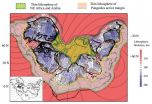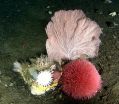New candidate genes for immunodeficiency identified by using dogs as genetic models
2015-07-30
(Press-News.org) IgA deficiency is one of the most common genetic immunodeficiency disorders in humans and is associated with an insufficiency or complete absence of the antibody IgA. Researchers led from Uppsala University and Karolinska Institutet in Sweden have now performed the first comparative genetic study of IgA deficiency by using the dog as genetic disease model. Novel candidate genes have been identified and the results are published in PLOS ONE.
People with low IgA are at higher risk for developing recurrent infections, allergies and autoimmunity. The underlying genetic factors of IgA deficiency are still largely unknown.
Previously the same research group identified several dog breeds prone to low IgA levels and also found that IgA levels vary widely between breeds [doi: 10.1016/j.vetimm.2014.05.010.160.]. In this current investigation, the researchers performed genome-wide association studies (GWAS) in four of these breeds prone to low IgA levels. Mia Olsson, postdoc at the Department of Medicine at Karolinska Institutet and shared first author of the study comment on the value of dogs when studying this disorder:
"Since certain dog breeds are prone to exhibit extremely low IgA levels and do present with similar symptoms as human IgA deficient patients, they represent excellent models to map genes involved in this highly complex disease".
The researchers particularly identified three novel candidate genes; KIRREL3 and SLIT1, with documented roles in immune cell development, and SERPINA9 expressed exclusively at the site (germinal center) where a B-cell starts producing IgA.
The researchers also present a newly developed method to analyze a complex continuous trait in GWAS. Katarina Tengvall, PhD candidate at the Department of Medical Biochemistry and Microbiology at Uppsala University and shared first author of the study, points out that a novel strategy was required in order to analyze this trait in dogs:
"Due to the great differences in IgA between dog breeds, no cut-off to distinguish normal from abnormal IgA levels in dogs has yet been established".
This hampers the classical way of performing GWAS in which groups of affected and unaffected usually are compared. Moreover, the use of a continuous GWAS was impeded by natural fluctuations of IgA concentrations.
"To facilitate robust GWASs, we divided dogs into series of percentile groups to reflect the breed-specific IgA distributions and performed multiple GWASs. In the end we combined them into one final GWAS in each breed, thereby removing spurious false signals and successfully defined the associated genomic regions", says Katarina Tengvall.
The researchers thus shed light to a complex disease by suggesting novel candidate genes as well as presenting a new method for analyzing a trait based on a continuous variable (in GWAS).
"We will continue to study these genes and their potential involvement in IgA deficiency in dogs and we anticipate that it will be of importance also for the human equivalent", says Mia Olsson.
INFORMATION:
For more information, please contact:
Mia Olsson: e-mail: Mia.Olsson@ki.se
Katarina Tengvall, tel: + 46 73-9452665, e-mail: Katarina.tengvall@imbim.uu.se
"Genome-Wide Analyses Suggest Mechanisms Involving Early B-Cell Development in Canine IgA Deficiency"
http://dx.plos.org/10.1371/journal.pone.0133844 (link activates when the embargo ends)
ELSE PRESS RELEASES FROM THIS DATE:
2015-07-30
Highly active anti-retroviral therapy (HAART) has helped millions survive the human immunodeficiency virus (HIV). Unfortunately, HIV has a built-in survival mechanism, creating reservoirs of latent, inactive virus that are invisible to both HAART and the immune system.
But now, researchers at UC Davis have identified a compound that activates latent HIV, offering the tantalizing possibility that the virus can be flushed out of the silent reservoirs and fully cured. Even better, the compound (PEP005) is already approved by the FDA. The study was published in the journal ...
2015-07-30
(SEOUL and BOSTON) - The concept of walking on water might sound supernatural, but in fact it is a quite natural phenomenon. Many small living creatures leverage water's surface tension to maneuver themselves around. One of the most complex maneuvers, jumping on water, is achieved by a species of semi-aquatic insects called water striders that not only skim along water's surface but also generate enough upward thrust with their legs to launch themselves airborne from it.
Now, emulating this natural form of water-based locomotion, an international team of scientists from ...
2015-07-30
A study by researchers at the National Institute of Allergy and Infectious Diseases and Duke University helps explain why the candidate vaccine used in the HVTN 505 clinical trial was not protective against HIV infection despite robustly inducing anti-HIV antibodies: the vaccine stimulated antibodies that recognized HIV as well as microbes commonly found in the intestinal tract, part of the body's microbiome. The researchers suggest that these antibodies arose because the vaccine boosted an existing antibody response to the intestinal microbiome, which may explain why ...
2015-07-30
Washington -- Thousands of nonhuman primates continue to be confined alone in laboratories despite 30-year-old federal regulations and guidelines mandating that social housing of primates should be the default. A new article co-authored by PETA scientists and Marymount University researchers, published in Perspectives in Laboratory Animal Science, argues that many laboratories cage primates alone--a harmful practice often done for convenience--and that the U.S. government isn't doing enough to address this growing problem.
Decades of research shows that housing highly ...
2015-07-30
Boulder, Colo., USA - Two hundred and fifty million years ago, all the major continents were joined together, forming a continent called Pangea (which means "all land" in Greek). The plate thickness of continents can now be measured using seismology, and it is surprisingly variable, from about 90 km beneath places like California or Western Europe, to more than 200 km beneath the older interiors of the U.S., Eastern Europe, and Russia.
Authors Dan McKenzie, Michael C. Daly, and Keith Priestley wondered what the pattern of plate thickness looked like before Pangea broke ...
2015-07-30
190 million Americans share the luxuries of human life with their pets. Giving dogs and cats a place in human homes, beds and--sometimes even, their wills--comes with the family member package.
Amongst these shared human-pet comforts is the unique luxury to overeat. As a result, the most common form of malnutrition for Americans and their companion animals results not from the underconsumption, but the overconsumption of food. The obesity epidemic also causes a similar array of diseases in people and pets: diabetes, hyperlipidemia and cancer.
During this year's ADSA-ASAS ...
2015-07-30
Do you ever notice how stress and mental frustration can affect your physical abilities? When you are worried about something at work, do you find yourself more exhausted at the end of the day? This phenomenon is a result of the activation of a specific area of the brain when we attempt to participate in both physical and mental tasks simultaneously.
Ranjana Mehta, Ph.D., assistant professor at the Texas A&M Health Science Center School of Public Health, conducted a study evaluating the interaction between physical and mental fatigue and brain behavior.
The study showed ...
2015-07-30
North of the Aleutian Islands, submarine canyons in the cold waters of the eastern Bering Sea contain a highly productive "green belt" that is home to deep-water corals as well as a plethora of fish and marine mammals.
Situated along the continental slope, the area also supports a thriving -- but potentially environmentally damaging -- bottom-trawling fishing industry that uses large weighted nets dragged across the seafloor to scoop up everything in their path.
A new study, conducted by research biologist Robert Miller of UC Santa Barbara's Marine Science Institute ...
2015-07-30
CAMBRIDGE, Mass--Two key physical phenomena take place at the surfaces of materials: catalysis and wetting. A catalyst enhances the rate of chemical reactions; wetting refers to how liquids spread across a surface.
Now researchers at MIT and other institutions have found that these two processes, which had been considered unrelated, are in fact closely linked. The discovery could make it easier to find new catalysts for particular applications, among other potential benefits.
"What's really exciting is that we've been able to connect atomic-level interactions of water ...
2015-07-30
A team of scientists has linked changes in the structure of a handful of central brain neurons to understanding how animals adjust to changing seasons. Its findings enhance our understanding of the mechanisms vital to the regulation of our circadian system, or internal clock.
The work, which appears in the journal Cell, focuses on the regulation of "neuronal plasticity"--changes in neuronal structure--and its function in the brain.
"Neuronal plasticity underpins learning and memory, but it is very challenging to tie changes in specific neurons to alterations in animal ...
LAST 30 PRESS RELEASES:
[Press-News.org] New candidate genes for immunodeficiency identified by using dogs as genetic models

